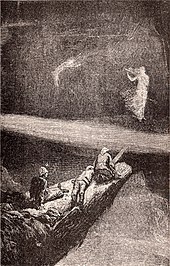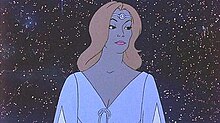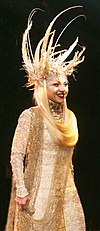Galadriel
| Galadriel | |
|---|---|
Celebrían | |
| Book(s) | The Fellowship of the Ring (1954) The Return of the King (1955) The Silmarillion (1977) Unfinished Tales (1980) |
Galadriel (IPA: [ɡaˈladri.ɛl]) is a character created by J. R. R. Tolkien in his Middle-earth writings. She appears in The Lord of the Rings, The Silmarillion, and Unfinished Tales.
She was a royal
The Tolkien scholar
Modern songwriters have created songs about Galadriel; Tolkien's Quenya poem "Namárië" has been set to music by Donald Swann. Galadriel has appeared in both animated and live-action films and television. Cate Blanchett played her in Peter Jackson's film series, while Morfydd Clark played her in an earlier age in The Lord of the Rings: The Rings of Power.
Fictional biography
Stories of Galadriel's life prior to the
According to the older account of her story, sketched by Tolkien in
Second Age
Galadriel and Celeborn travelled first to
Celeborn and Galadriel had a daughter,
During the
Third Age
'And now at last it comes. You will give me the Ring freely! In place of the Dark Lord you will set up a Queen. And I shall not be dark, but beautiful and terrible as the Morning and the Night! Fair as the Sea and the Sun and the Snow upon the Mountain! Dreadful as the Storm and the Lightning! Stronger than the foundations of the earth. All shall love me and despair!' [Galadriel] lifted up her hand and from the ring that she wore there issued a great light that illuminated her alone and left all else dark... Then she let her hand fall, and the light faded, and suddenly she laughed again, and lo! she was shrunken: a slender elf-woman, clad in simple white, whose gentle voice was soft and sad. 'I pass the test', she said. 'I will diminish, and go into the West and remain Galadriel'.
In
When the Fellowship left Lothlórien, she gave each member a gift and an Elven cloak, and furnished the party with supplies, both as practical support and as a symbol of faith, hope and goodwill. Her husband Celeborn likewise provided the Fellowship with Elven-boats.[T 10] On the day that the Fellowship left Lórien, but unknown to them,
After Sauron perished, Celeborn led the host of Lórien across the Anduin and captured Dol Guldur. Galadriel came forth and "threw down its walls and laid bare its pits".
Characteristics
The Dúnedain said that her height was two rangar, or "man-high" – some 6 feet 4 inches (193 cm).[T 14] However, Galadriel's most striking feature was her beautiful long silver-golden hair. The Elves of Tirion said it captured the radiance of the Two Trees Laurelin and Telperion themselves.[T 15]
Even among the Eldar she was accounted beautiful, and her hair is held a marvel unmatched. It is golden like the hair of her father and of her foremother Indis, but richer and more radiant, for its gold is touched by some memory of the starlike silver of her mother; and the Eldar say that the light of the Two Trees, Laurelin and Telperion, has been snared in her tresses.[T 15]
Many thought that this saying first gave to Fëanor the thought of imprisoning and blending the light of the Trees that later took shape in his hands as the Silmarils. For Fëanor beheld the hair of Galadriel with wonder and delight.[T 15]
Nevertheless, Galadriel never repaid Fëanor's admiration. Fëanor "had begged her thrice for a tress and thrice she refused to give him even one hair. It is said that these two kinsfolk, being considered the greatest of the Eldar of Valinor, remain unfriends forever."[T 15]
Her character was a blend of characteristics of the
She was proud, strong, and self-willed, as were all the descendants of Finwë save Finarfin; and like her brother Finrod, of all her kin the nearest to her heart, she had dreams of far lands and dominions that might be her own to order as she would without tutelage. Yet deeper still there dwelt in her the noble and generous spirit of the Vanyar, and a reverence for the Valar that she could not forget. From her earliest years she had a marvellous gift of insight into the minds of others, but judged them with mercy and understanding, and she withheld her goodwill from none save only Fëanor. In him she perceived a darkness that she hated and feared, though she did not perceive that the shadow of the same evil had fallen upon the minds of all the Noldor, and upon her own.[T 15]
Her sympathy for
Relationships
| Family tree[T 15] | |||||||||||||||||||||||||||||||||||||||||||||||||||||||||||||||||||||||||||||||||||||||||||||||||||||||||||||||||||||||||||||||||||||||||||||||||||||||||||||||||||||||||||||||||||||||||||||||||||||||||||||||||||||||||||||||||||||||||||||||||||||||||||||||||||||||||||||||||||||||||||||||||||||||||||||||||||||||||||||||||||||||||||||||||||||||||||||||||||||||||||||||||||||||||||||||||||||||||||||||||||||||||||||||||||||||||||||||||||||||||||||||||||||||||||||||||||||||||||||||||||||||||||||||||||||||||||||||||||||||||||||||||||||||||||||||||||||||||||||||||||||||||||||||||||||||||||||||||||||||||||||||||||||||||||||||||||||||||||||||||||||||||||||||||||||||||||||||||||||||||||||||||||||||||||||||||||||||||||||||||||||||||||||||||||||||||||||||||||||||||||||||||||||||||||||||||||||||||||||||||||||||||||||||||||||||||||||||||||||||||||||||||||||||||||||||||||||||||||||||||||||||||||||||||||||||||||||||||||||||||||||||||||||||||||||||||||||||||||||||||||||||||||||||||||||||||||||||||||||||
|---|---|---|---|---|---|---|---|---|---|---|---|---|---|---|---|---|---|---|---|---|---|---|---|---|---|---|---|---|---|---|---|---|---|---|---|---|---|---|---|---|---|---|---|---|---|---|---|---|---|---|---|---|---|---|---|---|---|---|---|---|---|---|---|---|---|---|---|---|---|---|---|---|---|---|---|---|---|---|---|---|---|---|---|---|---|---|---|---|---|---|---|---|---|---|---|---|---|---|---|---|---|---|---|---|---|---|---|---|---|---|---|---|---|---|---|---|---|---|---|---|---|---|---|---|---|---|---|---|---|---|---|---|---|---|---|---|---|---|---|---|---|---|---|---|---|---|---|---|---|---|---|---|---|---|---|---|---|---|---|---|---|---|---|---|---|---|---|---|---|---|---|---|---|---|---|---|---|---|---|---|---|---|---|---|---|---|---|---|---|---|---|---|---|---|---|---|---|---|---|---|---|---|---|---|---|---|---|---|---|---|---|---|---|---|---|---|---|---|---|---|---|---|---|---|---|---|---|---|---|---|---|---|---|---|---|---|---|---|---|---|---|---|---|---|---|---|---|---|---|---|---|---|---|---|---|---|---|---|---|---|---|---|---|---|---|---|---|---|---|---|---|---|---|---|---|---|---|---|---|---|---|---|---|---|---|---|---|---|---|---|---|---|---|---|---|---|---|---|---|---|---|---|---|---|---|---|---|---|---|---|---|---|---|---|---|---|---|---|---|---|---|---|---|---|---|---|---|---|---|---|---|---|---|---|---|---|---|---|---|---|---|---|---|---|---|---|---|---|---|---|---|---|---|---|---|---|---|---|---|---|---|---|---|---|---|---|---|---|---|---|---|---|---|---|---|---|---|---|---|---|---|---|---|---|---|---|---|---|---|---|---|---|---|---|---|---|---|---|---|---|---|---|---|---|---|---|---|---|---|---|---|---|---|---|---|---|---|---|---|---|---|---|---|---|---|---|---|---|---|---|---|---|---|---|---|---|---|---|---|---|---|---|---|---|---|---|---|---|---|---|---|---|---|---|---|---|---|---|---|---|---|---|---|---|---|---|---|---|---|---|---|---|---|---|---|---|---|---|---|---|---|---|---|---|---|---|---|---|---|---|---|---|---|---|---|---|---|---|---|---|---|---|---|---|---|---|---|---|---|---|---|---|---|---|---|---|---|---|---|---|---|---|---|---|---|---|---|---|---|---|---|---|---|---|---|---|---|---|---|---|---|---|---|---|---|---|---|---|---|---|---|---|---|---|---|---|---|---|---|---|---|---|---|---|---|---|---|---|---|---|---|---|---|---|---|---|---|---|---|---|---|---|---|---|---|---|---|---|---|---|---|---|---|---|---|---|---|---|---|---|---|---|---|---|---|---|---|---|---|---|---|---|---|---|---|---|---|---|---|---|---|---|---|---|---|---|---|---|---|---|---|---|---|---|---|---|---|---|---|---|---|---|---|---|---|---|---|---|---|---|---|---|---|---|---|---|---|---|---|---|---|---|---|---|---|---|---|---|---|---|---|---|---|---|---|---|---|---|---|---|---|---|---|---|---|---|---|---|---|---|---|---|---|---|---|---|---|---|---|---|---|---|---|---|---|---|---|---|---|---|---|---|---|---|---|---|---|---|---|---|---|---|---|---|---|---|---|---|---|---|---|---|---|---|---|---|---|---|---|---|---|---|---|---|---|---|---|---|---|---|---|---|---|---|---|---|---|---|---|---|---|---|---|---|---|---|---|---|---|---|---|---|---|---|---|---|---|---|---|---|---|---|---|---|---|---|---|---|---|---|---|---|---|---|---|---|---|---|---|---|---|---|---|---|---|---|---|---|---|---|---|---|---|---|---|---|---|---|---|---|---|---|---|---|---|---|---|---|---|---|---|---|---|---|---|---|---|---|---|---|---|---|---|---|---|---|---|---|---|---|---|---|---|---|---|---|---|---|---|---|---|---|---|---|---|---|---|---|---|---|---|---|---|---|---|---|---|---|---|---|---|---|---|---|---|---|---|---|---|---|---|---|---|---|---|---|---|---|---|---|---|---|---|---|---|---|---|---|---|---|---|---|---|---|---|---|---|---|---|---|---|---|---|---|---|---|---|---|---|---|---|---|---|---|---|---|---|---|---|---|---|---|---|---|---|---|---|---|---|---|---|---|---|---|---|---|---|---|---|---|---|---|---|---|---|---|---|---|---|---|---|---|---|---|---|---|---|---|---|---|---|---|---|---|---|---|---|---|---|---|---|---|---|---|---|---|---|---|---|
| |||||||||||||||||||||||||||||||||||||||||||||||||||||||||||||||||||||||||||||||||||||||||||||||||||||||||||||||||||||||||||||||||||||||||||||||||||||||||||||||||||||||||||||||||||||||||||||||||||||||||||||||||||||||||||||||||||||||||||||||||||||||||||||||||||||||||||||||||||||||||||||||||||||||||||||||||||||||||||||||||||||||||||||||||||||||||||||||||||||||||||||||||||||||||||||||||||||||||||||||||||||||||||||||||||||||||||||||||||||||||||||||||||||||||||||||||||||||||||||||||||||||||||||||||||||||||||||||||||||||||||||||||||||||||||||||||||||||||||||||||||||||||||||||||||||||||||||||||||||||||||||||||||||||||||||||||||||||||||||||||||||||||||||||||||||||||||||||||||||||||||||||||||||||||||||||||||||||||||||||||||||||||||||||||||||||||||||||||||||||||||||||||||||||||||||||||||||||||||||||||||||||||||||||||||||||||||||||||||||||||||||||||||||||||||||||||||||||||||||||||||||||||||||||||||||||||||||||||||||||||||||||||||||||||||||||||||||||||||||||||||||||||||||||||||||||||||||||||||||||
Analysis
Reconstructed Old English elf
The critic
Angelic being
Shippey also considers the Christian
Arthurian figure
The Tolkien scholar
| Attribute | Galadriel | Ayesha (She) | The Lady of Shalott |
|---|---|---|---|
| Image |  Tessa Boronski, 2011 |
 Edward Killingworth Johnson, 1887 |
 John William Waterhouse, 1888 |
| Life | immortal Elf | immortal human after entering the flame |
"fairy" |
| Beauty | very fair long blonde hair |
men fall to their knees long raven-black hair |
great beauty very long dark hair |
| Wisdom Power |
sees more than any man
|
dangerous and strange | |
| Work | weaving, and overseeing weaver-maidens
|
weaves continually | |
| Place | isolated realm, sheltered from change
|
enchanted island | |
| Healing | heals and preserves
|
enchanted | |
| Magic mirror (dish of water) |
sees past, present, "things that may yet be" denies it is magic |
sees past and present denies it is magic |
"the mirror's magic sights" |
| Ending | her ring loses power elves leave and diminish |
re-enters the flame shrivels up and dies |
relinquishes power and dies |
Medieval celestial lady
Sarah Downey, in
| Attribute | Galadriel | Pearl-maiden | Dante's Matelda | Dante's Beatrice |
|---|---|---|---|---|
| Image | Frodo to look into her mirror-fountain, the light of a star shining through her ring-finger. , scraperboard, 1981
Alexander Korotich |
 Cotton MS Nero A X |
 John William Waterhouse, c. 1915 |
 Henry Holiday, 1883 |
| Celestial lady who gives guidance | Lady of Lothlórien | yes | yes | yes |
Earthly Paradise |
Lothlórien is like Aman, but in Middle-earth | Otherworldly garden, Heaven just across the stream | Guides Dante through the Garden of Eden | At top of Mount Purgatory, near but not in Heaven
|
| River-as-boundary | Between two rivers | Clear stream, with Heaven on far side | Bathes Dante in river Lethe | Across a pure stream |
| Dreamlike time | Timeless land; Elves are immortal | is dead | is dead | is dead |
Allegorical |
No, she is "penitent", a fully-developed character | yes | yes | yes |
| Ordeal, loss, death | yes, Gandalf has just been lost in Moria | yes | yes | yes |
| Water and light | "tall and white and fair"; light of Nenya , the Ring of Water |
white and gold | "clothed in the colour of a living flame" | |
| Vision and redemption | Sam sees destruction in the Shire in Galadriel's Mirror; Frodo glimpses "parts of a great history in which he had become involved", is enjoined not to touch the water; test is for Galadriel (not the narrator), tempted to take the One Ring | Narrator looks across the stream to the Heavenly Jerusalem; he jumps into stream and wakes up | Dante's vision within a vision, a pageant with Beatrice |
Homeric benefactor
The Tolkien scholar Mac Fenwick compares Galadriel and what he sees as her monstrous opposite, the giant and evil spider
| Attribute | Galadriel | Circe and Calypso |
|---|---|---|
| Place | own magical realm
| |
| Assistance | help and advice
| |
| Monstrous opposites |
Shelob,
giant spider of darkness |
Scylla and Charybdis ,who would destroy his ship |
| Gifts | cloaks, food, wisdom, light
| |
Jungian archetypes

Patrick Grant, a scholar of
Legacy in music
Tolkien wrote a poem "
Galadriel's songs are omitted from Howard Shore's music for The Lord of the Rings film series;[10] instead, Shore created a Lothlórien/Galadriel theme using the Arabic maqam Hijaz scale to create a sense of antiquity.[a][11]
On their album
Adaptations

Galadriel was voiced by Annette Crosbie in Ralph Bakshi's 1978 animated film of The Lord of the Rings,[17] and by Marian Diamond in BBC Radio's 1981 serialisation.[18]

In Peter Jackson's Lord of the Rings and The Hobbit trilogies, Galadriel is played by Cate Blanchett.[19] In The Lord of the Rings: The Fellowship of the Ring, Galadriel narrates the prologue that explains the creation of the One Ring, as well as appearing in Lothlórien.[20]

While Galadriel does not feature in Tolkien's The Hobbit, the story was amended so that she could appear in Jackson's films based on the book.[22]
On stage, Galadriel was portrayed by Rebecca Jackson Mendoza in the 2006 Toronto musical production of The Lord of the Rings; Mendoza's dress was hand-embroidered with some 1800 beads.[21] The musical was revised and moved to London's Theatre Royal, Drury Lane in 2007, with Laura Michelle Kelly in the "glittering" role.[23]
Galadriel appears in video games such as The Lord of the Rings: The Battle for Middle-earth II, where she is voiced by Lani Minella.[24]
In the 2022 television series The Lord of the Rings: The Rings of Power, young Galadriel was portrayed by Morfydd Clark,[25] and her younger version by Amelie Child Villiers.[26]
Notes
- ^ Lothlórien/Galadriel theme Archived 11 March 2007 at the Wayback Machine (listening sample)
References
Primary
- ^ Of the Rings of Power and the Third Age"
- ^ a b c Tolkien 1955, Appendix B, "The Tale of Years"
- ^ a b c d e Tolkien 1980, 4. "The History of Galadriel and Celeborn", "Concerning Galadriel and Celeborn"
- ^ Tolkien 1977, "Quenta Silmarillion", ch. 9 "Of the Flight of the Noldor"
- ^ Tolkien 1980, part 2, ch. 4 "The History of Galadriel and Celeborn" discusses "the reasons and motives given for Galadriel's remaining in Middle-earth", citing The Road Goes Ever On.
- ^ Tolkien 1977, "Quenta Silmarillion", ch. 13 "Of the Return of the Noldor"
- ^ Tolkien 1977, "Quenta Silmarillion", ch. 15 "Of the Noldor in Beleriand"
- ^ Tolkien 1954a, book 2 ch. 6 "Lothlórien"
- ^ a b Tolkien 1954a, book 2 ch. 7 "The Mirror of Galadriel"
- ^ Tolkien 1954a, book 2 ch. 8 "Farewell to Lórien"
- ^ Tolkien 1954, book 3, ch. 5 "The White Rider"
- ^ Tolkien 1955, book 6, ch. 9 "The Grey Havens"
- ^ Tolkien 1954a, "Prologue", "Note on the Shire Records"
- ^ Tolkien 1980, part 3, ch. 1 "The Disaster of the Gladden Fields: Appendix (Númenórean Linear Measures)"
- ^ a b c d e f g h Tolkien 1980, part 2, ch. 4 "The History of Galadriel and Celeborn"
Secondary
- ^ ISBN 0261102753.
- ISBN 0261102753.
- ^ ISBN 978-0-8020-3806-7.
- ^ a b Downey, Sarah (2011). "Cordial Dislike: Reinventing the Celestial Ladies of Pearl and Purgatorio in Tolkien's Galadriel". Mythlore. 29 (3). Article 8.
- ^ a b c Fenwick, Mac (1996). "Breastplates of Silk: Homeric Women in The Lord of the Rings". Mythlore. 21 (3). article 4.
- ^ a b c d e f g Grant, Patrick (1973). "Tolkien: Archetype and Word". Cross Currents (Winter 1973): 365–380. Archived from the original on 2021-12-03. Retrieved 2020-08-19.
- ^ Burns, Marjorie. "Double". In Drout, Michael D.C. (ed.). The J. R. R. Tolkien Encyclopedia. Routledge. p. 128.
- ^ Burns, Marjorie. "Shelob". In Drout, Michael D.C. (ed.). The J. R. R. Tolkien Encyclopedia. Routledge. p. 606.
- ^ Hargrove, Gene (January 1995). "Music in Middle-Earth". University of North Texas. Retrieved 8 July 2012.
- ^ Jorgensen, Estelle R. (December 2004). "Music, Myth, and Education: The Case of The Lord of the Rings Film Trilogy" (PDF). Reasons of the Heart: Myth, Meaning and Education, an International Conference, University of Edinburgh, September 9–12, 2004: 6–7.
- ISBN 978-0-7390-7157-1.
- ISBN 978-1904994107.
- ^ "Galadriel". Barclay James Harvest. Retrieved 12 May 2020.
- ^ Library of Congress Copyright Office (1977). Catalog of Copyright Entries: Third series. p. 1618.
- ^ Gramophone. Vol. 61. C. Mackenzie. 1983. p. 541.
- ISBN 1-86508-072-1. Archivedfrom the original on 3 August 2004. Retrieved 23 August 2019.
- ISBN 978-1-56976-222-6.
- ^ "Riel Radio Theatre — The Lord of the Rings, Episode 2". Radioriel. 15 January 2009. Archived from the original on 15 January 2020. Retrieved 18 May 2020.
- ^ "Torn Exclusive: Cate Blanchett, Ken Stott, Sylvester McCoy, Mikael Persbrandt join cast of Peter Jackson's "The Hobbit"". 7 December 2010. Retrieved 7 December 2010.
- ^ Harl, Allison (Spring–Summer 2007). "The monstrosity of the gaze: critical problems with a film adaptation of The Lord of the Rings". Mythlore. 25 (3). Article 7.
- ^ a b c Brantley, Ben (24 March 2006). "Tolkien's 'Lord of the Rings,' Staged by Matthew Warchus in Toronto". The New York Times. Retrieved 29 May 2020.
- ^ Child, Ben (8 December 2010). "Peter Jackson tinkers with Tolkien to hand Cate Blanchett Hobbit role". The Guardian. Retrieved 29 May 2020.
- ^ Billington, Michael (19 June 2007). "Guardian review, "The Lord of the Rings"". The Guardian. Retrieved 22 April 2012.
- ^ "Galadriel". Behind the Voice Actors. Retrieved 29 May 2020.
- ^ Kroll, Justin (17 December 2019). "'Lord of the Rings' Series Taps Morfydd Clark as Young Galadriel". Variety. Retrieved 17 December 2019.
- ^ Welch, Andy (2 September 2022). "The Lord of the Rings: The Rings of Power recap episodes one and two – like no TV you've seen before". The Guardian. Retrieved 3 September 2022.
Sources
- OCLC 9552942.
- OCLC 1042159111.
- OCLC 519647821.
- ISBN 978-0-395-25730-2.
- ISBN 978-0-395-29917-3.
Related articles
- The Phial of Galadriel
